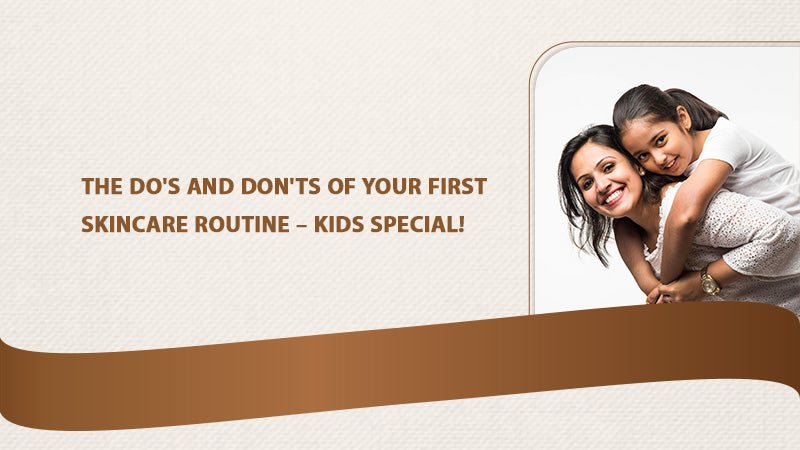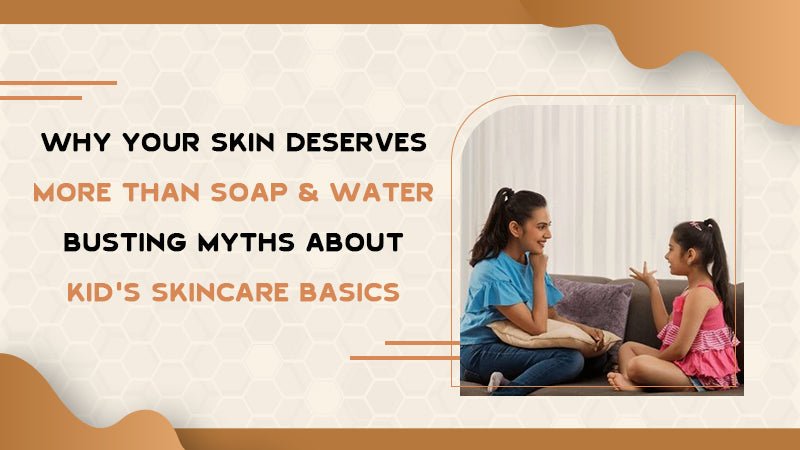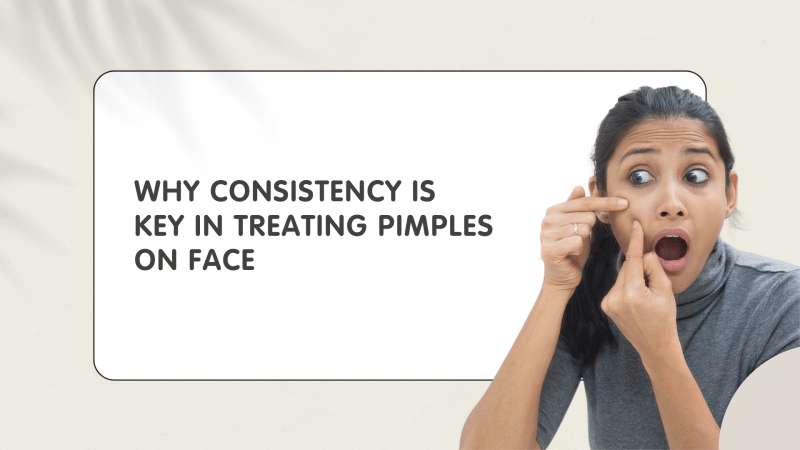Protecting Your Child's Skin: A Parent's Guide to Sunscreens
It’s summer time. As you gear up for some fun in the sun with your kids, you need to make sure their precious skin remains shielded from harmful UV rays.
And what better way to do that with a great sunscreen?
Join us on this informative journey as we explore everything you need to know about sunscreens and how to keep your child's skin protected all year round. Let's dive in!
To understand the importance of sunscreens, we need to understand UV rays.
UVA Rays vs. UVB Rays
Understanding the difference between UVA and UVB rays is crucial for comprehensive sun protection.
UV rays can cause immediate and long-term damage. UVB rays primarily cause sunburn, while UVA rays penetrate deeper into the skin and contribute to premature ageing, wrinkles and long-term skin damage.
And so, it becomes an absolute must to protect your kid’s skin against both UVA and UVB rays.
Sunscreen - The Best Protection
Sunscreen is a crucial step to protect your child's skin from the damaging effects of the sun's UV rays. Prolonged exposure to these rays can lead to sunburn, premature ageing, and even an increased risk of skin cancer.
By applying sunscreen, you create a protective barrier that absorbs or reflects the harmful UV rays, reducing the risk of skin damage.
But What If There Is No Sun?
Sunscreen must be applied even on cloudy or overcast days.
UV rays can still penetrate through clouds and cause skin damage. It's important to incorporate sunscreen as a regular part of your child's daily skincare routine, regardless of the weather conditions.
And the most important thing to consider when getting a sunscreen is, by no doubt, understanding SPF.
Know Your SPF
To keep it simple, SPF is the Sun Protection Factor. It indicates how well your sunscreen protects your kid’s skin against UVB rays, which are primarily responsible for sunburn.
The SPF number represents the level of protection provided. For example, SPF 30 means the sunscreen filters out approximately 97% of UVB rays.
Now that you’ve got the basic understanding of what SPF is, it is natural for the big question to arise as a parent…
What SPF Is Good For Kids?
When you’re picking a sunscreen, it's necessary to choose a sunscreen with at least a minimum SPF of 30 to ensure effective protection.
And it’s the same for kids!
When it comes to kids, it's best to use a sunscreen with an SPF of 30 or higher because this level of protection offers adequate coverage against UVB rays and helps prevent sunburn that most kids’ skins are usually prone to.
But remember, no sunscreen can provide 100% protection. Sunscreen is an important step that mustn't be skipped in your kid’s skincare routine, but it’s also important to combine sunscreen with other sun protection measures like seeking shade and wearing protective clothing.
So SPF solved the problem of UVB rays. But what about the UVA rays?
That brings us to the next important step to consider when choosing a sunscreen - PA ratings.
What Are PA Ratings?
PA ratings indicate the level of protection that your sunscreen provides against UVA rays, which penetrate deeper into the skin and contribute to long-term damage.
PA ratings are denoted by plus signs. The more plus signs in the PA rating, the higher the protection.
So start looking for sunscreens with a PA+++ rating to ensure your child is adequately shielded from UVA rays.
Great! We’ve mastered UV rays. We’re already halfway there.
To become a sunscreen guru, you need to understand the difference between the two types of sunscreens - Mineral-based and Chemical-based.
Chemical-Based Sunscreens
Chemical sunscreens, also known as organic sunscreens, contain active chemical ingredients, like oxybenzone, avobenzone, and octinoxate. These chemicals work by absorbing UV rays and converting them into heat, which is then released from the skin.
But while chemical sunscreens are widely used and effective for sun protection, there are a few harmful effects that can be seen when used on children:
Potential Skin Sensitivities: Some children may be more prone to skin sensitivities or allergic reactions to certain chemical sunscreen ingredients. Common side effects can include redness, itching, and skin irritation. It's important to patch test new sunscreen products before applying them to your child's entire body.
Absorption of Chemicals: Chemical sunscreens are designed to be absorbed into the skin, where they work to protect against UV radiation.
But, this absorption raises concerns for some parents, as certain chemical ingredients have been found in the bloodstream after topical application. While more research is needed to understand the implications fully, some parents prefer to opt for mineral sunscreens to minimise potential chemical exposure.
Sunscreen Breakdown in Sunlight: Certain chemical sunscreen ingredients can break down when exposed to sunlight. This degradation can reduce the effectiveness of the sunscreen over time, requiring more frequent reapplication to maintain adequate protection.
Wait Time for Effectiveness: Unlike mineral sunscreens that provide immediate protection, chemical sunscreens require a waiting period after application before they become effective. This wait time can range from 15 to 30 minutes, depending on the product. It's important to factor in this waiting period when planning outdoor activities with your child.
Allergy Triggers: Some chemical sunscreen ingredients, such as oxybenzone, have been associated with allergic reactions in certain individuals. If your child has a history of skin allergies or sensitivities, it's advisable to consult with a dermatologist or paediatrician to determine the best sunscreen option for them.
Keeping these factors in mind, it becomes a need to explore other options, and don’t worry, here’s an option that’s exactly what you’re looking for as a super-parent!
Mineral-Based Sunscreens
Mineral sunscreens are also known as physical sunscreens.
They rely on active mineral ingredients, like zinc oxide and titanium dioxide, to provide effective sun protection. These minerals work by sitting on the skin's surface and creating a physical barrier that reflects and scatters UV rays away from the skin.
These are some key benefits of using a mineral-based sunscreen:
Gentle and Safe: Mineral sunscreens are generally well-tolerated by children, including those with sensitive or reactive skin. They have a lower risk of causing irritation or allergic reactions, making them a suitable option for kids with skin conditions like eczema.
Immediate Protection: Once applied, mineral sunscreens provide immediate protection against the sun's rays. There's no need to wait for them to activate, unlike some chemical sunscreens that require a waiting period before becoming effective.
Broad-Spectrum Protection: Mineral sunscreens offer broad-spectrum protection, meaning they guard against both UVA and UVB rays. This comprehensive coverage ensures that your child's skin is shielded from immediate sunburn and long-term damage caused by UV radiation.
Photostable: Mineral sunscreen ingredients like zinc oxide, are photostable, meaning they do not degrade or break down when exposed to sunlight. This stability ensures that the sunscreen remains effective for a longer duration, providing consistent protection for your kid.
Reduced Risk of Absorbing Harmful Chemicals: Unlike chemical sunscreens, mineral sunscreens do not penetrate the skin. Instead, they create a protective barrier on the skin's surface. This reduces the potential risk of absorbing potentially harmful chemicals into your child's body.
Considering the above factors, mineral sunscreens are often considered a better choice for kids, especially for those with sensitive skin. The physical barrier they create on the skin's surface offers immediate and broad-spectrum protection without the concerns of chemical absorption or potential skin sensitivities!
Where to look for a sunscreen that fits the brief for your kid’s skin?
That’s where Tikitoro comes in.
The Ultimate Sun Protection For Your Kids
We have introduced a new age of personal care, that is, products that are especially designed for kids and teenagers.
Our Kids range offers a dermatologist-tested formula that is suitable for kids aged 4-10 years old, making sure their delicate skin receives the care and protection it deserves!
The Tikitoro Kids Sunscreen is a mineral-based sunscreen that prioritises the safety and well-being of your child's skin. By using zinc oxide as a key ingredient, it provides broad-spectrum protection against UVA and UVB rays without the need for potentially irritating or allergenic chemicals!
With Tikitoro, you can have peace of mind knowing that your child's skin is protected with a sunscreen that is gentle, effective, and minimises the risk of adverse reactions.
Its SPF 30+ and PA+++ ensure that your child's skin remains safe from harmful UV rays while enjoying outdoor activities.
Take the necessary steps to safeguard your child's skin and make Tikitoro Kids Sunscreen an essential part of their sun care routine. Your child's skin deserves the best, and Tikitoro Kids Sunscreen delivers just that.
Reduces Transepidermal Water Loss: Sun exposure can lead to moisture loss from the skin, resulting in dryness and discomfort. Tikitoro Kids Sunscreen is specially formulated to reduce transepidermal water loss, helping to keep your child's skin hydrated and healthy.
Improves Skin Complexion: Tikitoro Kids Sunscreen is enriched with niacinamide, a potent ingredient known for its ability to improve skin tone and texture. By incorporating this sunscreen into your child's routine, you can support their skin's natural radiance and evenness.
Hydrates the Skin: Keeping your child's skin hydrated is vital for maintaining its overall health. Tikitoro Kids Sunscreen is designed to provide essential hydration, ensuring that their skin stays moisturised, nourished, and protected throughout the day.
Prevents Sun Damage: With its powerful SPF 30+ and PA+++, Tikitoro Kids Sunscreen forms a protective barrier on your child's skin, effectively shielding it from harmful UV rays. By preventing sunburn and skin damage, this sunscreen helps maintain your child's skin health in the long run.
Includes Soothing Chamomile: Chamomile is renowned for its soothing properties, making it an excellent addition to Tikitoro Kids Sunscreen. The inclusion of chamomile helps calm and comfort your child's skin, providing an extra layer of care and protection.
Contains Zinc Oxide: Tikitoro Kids Sunscreen incorporates zinc oxide, a mineral ingredient that offers broad-spectrum UV protection. Acting as a physical barrier, zinc oxide reflects and scatters UV rays, effectively safeguarding your child's skin from sun damage.
So you’ve chosen the perfect sunscreen. What’s the next step?
Sunscreen Application
Proper application of sunscreen is essential for effective protection. As a general guideline, use a sufficient amount of sunscreen to cover all exposed areas of your child's body.
Using Tikitoro Kids Sunscreen is easy. Simply take a sufficient amount, about two adult fingers’ worth, and apply it evenly to your child's face and neck. It's recommended to apply the sunscreen at least 15 minutes before going outside to allow it to fully absorb into the skin.
And make sure you’re paying extra attention to commonly overlooked areas like the ears, back of the neck, and tops of the feet!
For optimal protection, remember to reapply Tikitoro Kids Sunscreen every two hours, especially if your child has been swimming or perspiring. This ensures that the protective barrier is maintained and your child's skin remains shielded from the sun's harmful rays.
Protecting your child's skin from the sun is a vital aspect of their overall well-being. By choosing the right sunscreen and following proper application techniques, you can ensure that your child stays safe and gets the best benefits out of the bottle.
Don't compromise when it comes to your child’s well-being. Click here to shop on the best personal care for your kids today with Tikitoro.




